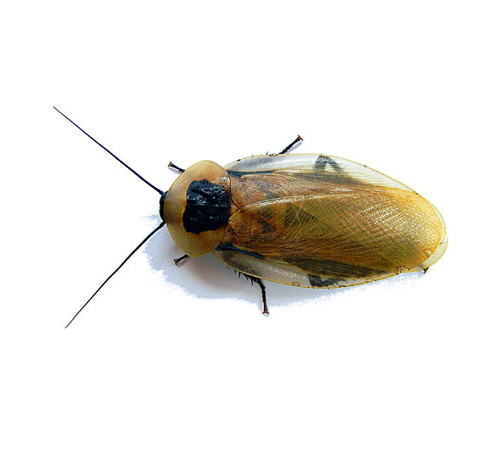Hover or click each cockroach to view it's name and/open a link for more information.

Cockroaches are a member of the order Blattodea. There are 4600 known cockroach species worldwide of this number only 30 of these can be found within human populations. Cockroaches are resilient creatures that have inhabited the earth for an estimate 320 million years. They can be found in a variety of environments from the most temperate regions in the Arctic to sweltering tropical regions. Modern cockroaches are highly adaptable and are found throughout the globe with tropical regions being home to the largest populations of the insect.
Contrary to popular belief not all cockroaches are categorized as pests. Cockroaches which generally fall into this category include, the German cockroach, the American cockroach, the Oriental cockroach, the Australian cockroach, the Smoky Brown Cockroach and less so the Tropical Cockroach.
Cockroaches live within large social structures. All species of cockroaches aggregate and exhibit social characteristics including nurturing their young. Cockroaches tend to follow and are attracted to other cockroaches. This means that fecal matter, or other residue from any specie can be picked up by members within its group. This allows for swarm behaviour and possible infestations in areas that are ideal for breeding and feeding.
Cockroaches are most attracted to areas that are warm, dark and have readily available access to water. They are typically nocturnal and tend to emerge during the night time, where they are better able to hide in plain sight and forage for bits of food particles. They are usually omnivorous and consume a wide range of items including fruits, rice, pasta, bread, paper, skin flakes, dead insects, soiled clothing and hair.

German cockroaches, Blattella germanica (L.), are the most common cockroaches found in houses and restaurants. Most cockroaches have a flattened, oval shape, spiny legs, and long, filamentous antennae. Immature stages are smaller, have undeveloped wings and resemble the adults. They eat food of all kinds and may hitch-hike into the house on egg cartons, soft drink cartons, sacks of potatoes or onions, used furniture, beer cases, etc.
Adults are about 5/8 inch long (17mm). Adult German cockroaches are light brown except for the shield behind the head marked with two dark stripes, which run lengthwise on the body. Young roaches are wingless and nearly black with a single light stripe running down the middle of the back. Egg capsules are light tan.
Roaches can contaminate food, damage wallpaper and books, eat glue from furniture, and produce an unpleasant odor. Some people are allergic to roaches. The pests can contaminate food with certain bacterial diseases that result in food poisoning, dysentery, or diarrhea. Without food or water, adults may die in two weeks, but they can survive for up to one a month consuming only water.
German cockroach females, unlike most other roaches, carry the egg capsule protruding from their abdomen until the eggs are ready to hatch. The case is then placed in a secluded location, with the nymphs emerging one to two days later. A female may produce four to six cases during her lifetime, each containing 30 to 40 eggs. Eggs hatch in 28 to 30 days, and nymphs develop in 40 to 125 days.
Female roaches live about 200 days while male roaches have a shorter life span. The roach produces more eggs and has more generations per year (three to four) than other roaches, and only a few individuals are needed to develop into troublesome infestations.
German cockroaches develop into adulthood in 3 separate phases: egg, nymph and adult. Typically a German cockroach will live for 100 days, with female cockroaches living as much as 200 days. The life span of a German cockroach will vary based on climate, access to sustenance and the impact/occurrence of injuries.

American cockroach adults are 1 and 1/2 inches long (38mm). They are reddish brown and have a yellowish margin on the body region behind the head. When disturbed, they may run rapidly and adults may fly. Immature cockroaches resemble adults except that they are wingless. American cockroaches generally live in moist areas, but can survive in dry areas if they have access to water. They prefer warm temperatures around 84 degrees Fahrenheit and do not tolerate cold temperatures.
These cockroaches are common in basements, crawl spaces, man holes, pits and walkways adjacent to buildings. They feed on a wide variety of plant and animal material.
Females produce egg cases and carry them protruding from the tip of the abdomen for about two days. Egg cases are then generally placed on a surface in a hidden location. Egg cases are 3/8 inch long, brown, and purse shaped. Immature cockroaches emerge from egg cases in 6 to 8 weeks and require 6 to 12 months to mature. Adult cockroaches can live up to one year, during which females produce an average of 150 young. American cockroaches are the largest of the common roaches.
Signs of an infestation of American cockroaches includes droppings in dark areas of the house and/or those with plumbing like laundry rooms, bathrooms and under cupboards.

Female cockroaches lay eggs within a few hours to days after a mating. A nymph emerges between 24 to 38 days where it matures to adulthood within the span of a few weeks. American cockroaches live on average for one year. This may vary based on access to food and water, injuries and climate.



